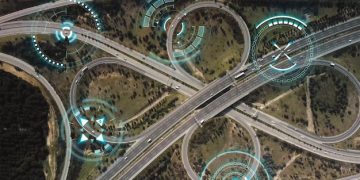Autonomous Vehicles & US Infrastructure: 2030 Impact

By 2030, autonomous vehicles are expected to profoundly reshape US transportation infrastructure, necessitating adaptation in road design, traffic management, and urban planning to accommodate advanced vehicle technologies and shifting mobility patterns.
The vision of self-driving cars navigating our roads independently is rapidly moving from science fiction to reality. But as these advanced machines become more prevalent, a critical question emerges: How Will Autonomous Vehicles Impact US Transportation Infrastructure by 2030? This transformative shift promises to fundamentally alter how we perceive, design, and utilize our nation’s extensive network of roads, bridges, and supportive systems.
The Dawn of Driverless Mobility: A New Era for Roads
As autonomous vehicles (AVs) increasingly permeate society, their integration into existing transportation networks presents both immense opportunities and significant challenges for infrastructure. By 2030, the US is poised to see a measurable presence of AVs, necessitating a re-evaluation of how our roads are built, maintained, and operated.
The transition period will likely be complex, with human-driven and autonomous vehicles sharing the same roadways. This mixed fleet scenario demands infrastructure solutions that cater to both, potentially leading to hybrid systems and gradual updates rather than immediate, wholesale overhauls.
Redefining Roadway Design and Capacity
Traditional road design has primarily focused on human drivers, accounting for reaction times, visual cues, and the limitations of human perception. AVs, with their precision, rapid processing, and connectivity, can potentially optimize road space far more efficiently.
- Lane Optimization: AVs can maintain closer following distances and perform more uniform maneuvers, theoretically increasing lane capacity by 25-50%.
- Dynamic Lane Use: Software-defined lanes could reconfigure based on real-time traffic flow, shifting from general purpose to AV-only or vice versa.
- Smart Intersections: AVs could coordinate passage through intersections without full stops, drastically reducing congestion and idling times.
The focus will shift from merely moving vehicles to optimizing the flow of data and energy. Road infrastructure will need to become an active participant in the communication network that underpins AV operation, collecting and transmitting data on road conditions, traffic patterns, and potential hazards.
Ultimately, the impact on roadway design will be a move towards “smarter” roads that are less about rigid physical structures and more about intelligent, adaptive systems capable of interacting seamlessly with their autonomous users. This evolution will require substantial investment in digital overlays and sensory capabilities.
Technological Integration: Smart Infrastructure and Connectivity
The widespread adoption of autonomous vehicles hinges not just on the vehicles themselves, but on a symbiotic relationship with an intelligent transportation infrastructure. By 2030, this integration will become a paramount concern, driving significant investment and innovation in the US.
Connectivity is the cornerstone of this future. Vehicle-to-everything (V2X) communication, encompassing vehicle-to-vehicle (V2V), vehicle-to-infrastructure (V2I), vehicle-to-pedestrian (V2P), and vehicle-to-network (V2N) interactions, will transform static roads into dynamic, data-rich environments. This constant flow of information will enable AVs to operate safely and efficiently, responding to real-time conditions rather than relying solely on onboard sensors.
The Role of Advanced Sensors and Communication Networks
For AVs to function optimally, infrastructure must provide reliable communication and sensory information that supplements the vehicle’s independent capabilities. This includes deploying a dense network of sensors, cameras, and communication beacons along roadways.
- Traffic Flow Monitoring: Sensors can provide granular data on vehicle speed, density, and flow, informing optimal routing for AVs.
- Hazard Detection: Infrastructure sensors can detect road hazards like potholes, debris, or icy patches, transmitting warnings to approaching AVs.
- Signal Prioritization: V2I communication can allow emergency AVs to receive green light priority, improving response times.
The advent of 5G networks is critical here, offering the low latency and high bandwidth required for instantaneous data exchange between vehicles and infrastructure. Without robust, ubiquitous connectivity, the full potential of AVs, particularly those relying on platooning or highly coordinated movements, cannot be realized. Furthermore, cybersecurity becomes a major concern; a connected infrastructure is also a vulnerable one, requiring sophisticated defenses.

Ensuring interoperability among different AV systems and infrastructure components is another significant challenge. Standardized protocols and open platforms will be essential to prevent a fragmented system where vehicles from different manufacturers cannot effectively communicate with each other or with the infrastructure. This technological push transforms transportation infrastructure from simple physical assets into complex, integrated IT systems. Local and federal governments, along with private sector partners, will need to collaborate intensely to build out and manage this intricate network.
Urban Planning and Land Use: Reshaping Cities
The rise of autonomous vehicles is poised to have a ripple effect far beyond the immediate confines of the road network, fundamentally reshaping urban planning and land use patterns by 2030. Cities, designed over centuries around human-driven vehicles and their associated needs, will need to adapt to a new paradigm of mobility.
One of the most significant impacts could be on parking infrastructure. If shared autonomous vehicles (SAVs) become prevalent, the need for vast swathes of land dedicated to parking lots and garages could diminish significantly. SAVs could constantly be in motion, serving multiple users, or “cruise” to designated off-street holding areas when not in use. This frees up valuable urban land that could be repurposed for housing, green spaces, commercial development, or pedestrian-friendly zones.
Transforming Parking and Reducing Congestion
The reduction in parking demand is not just about freeing up space; it also has profound implications for urban density and walkability. A city less burdened by parking infrastructure can become more compact and livable, reducing reliance on personal vehicle ownership.
- Repurposing Garages: Existing parking structures could be converted into mixed-use developments, vertical farms, or last-mile logistics hubs.
- Decreased Traffic: Optimized routing and platooning enabled by AVs could reduce congestion, making urban travel more predictable and efficient.
- Enhanced Public Spaces: Freed-up street space could be reclaimed for broader sidewalks, bike lanes, or outdoor dining, improving urban quality of life.
The reduction in vehicle ownership facilitated by ride-sharing AV fleets could also lead to a decrease in traffic volume, even without a significant increase in road capacity. This shift could make public transportation more appealing as part of an integrated, multimodal mobility network, especially for first and last-mile connections.
However, an alternative scenario suggests that if AVs make solo travel excessively convenient and affordable, they could increase vehicle miles traveled (VMT), leading to more sprawl and congestion, especially if empty vehicles are driving around awaiting their next passenger. Urban planners are actively modeling these scenarios to anticipate and mitigate potential negative outcomes, emphasizing the importance of policy development alongside technological integration.
Economic and Social Implications: A Shifting Landscape
The advent of autonomous vehicles will not only reshape physical infrastructure but also trigger profound economic and social shifts. By 2030, these changes will likely be felt across various sectors, from job markets to consumer behavior, necessitating proactive planning and adaptation.
Job displacement in the transportation sector, particularly for professional drivers (truckers, taxi drivers, bus operators), is a widely discussed concern. While AVs promise increased efficiency and safety, they also threaten livelihoods. This economic disruption will require robust retraining programs, educational initiatives, and potentially new social safety nets to support affected workers during the transition.
Workforce Restructuring and New Industries
While some jobs may be lost, the AV paradigm is also expected to create new ones, particularly in technology development, infrastructure maintenance, data analytics, cybersecurity, and fleet management. The focus shifts from driving to overseeing and optimizing autonomous systems.
- Software and AI Development: Increased demand for engineers, AI specialists, and data scientists to refine AV algorithms.
- Infrastructure Maintenance: New roles for maintaining smart road infrastructure, sensors, and communication networks.
- Fleet Management and Logistics: Growth in operations and maintenance of large-scale AV fleets.
Beyond employment, AVs could democratize mobility for certain populations. The elderly, individuals with disabilities, and those unable to drive could gain unprecedented independence, fostering greater social inclusion. This improved accessibility could reduce social isolation and enhance access to employment, healthcare, and education.

Economically, the logistics industry stands to benefit from reduced labor costs, optimized routes, and 24/7 operation, potentially lowering the cost of goods and enhancing supply chain efficiency. Insurance models will dramatically change, shifting liability from human error to software and hardware manufacturers. This will require new regulatory frameworks and specialized insurance products, potentially leading to lower premiums for consumers as accident rates decline. Ultimately, the economic and social fabric of the US will be intricately woven with the presence of AVs, defining new patterns of work, leisure, and community interaction.
Policy and Regulatory Frameworks: Navigating the Future
The integration of autonomous vehicles into the US transportation infrastructure by 2030 critically depends on the evolution of robust and cohesive policy and regulatory frameworks. Without clear guidelines, the promise of AVs could be undermined by legal ambiguities, safety concerns, and fragmented adoption across states.
Currently, the regulatory landscape for AVs in the US is a patchwork of state-specific laws, with varying approaches to testing, deployment, and liability. This creates challenges for manufacturers and operators seeking to deploy AVs nationwide. The lack of a unified federal framework hinders large-scale, consistent development and deployment.
Harmonizing Laws and Addressing Liability
A key challenge is the need for harmonized laws across states, or ideally, a comprehensive federal regulatory approach that provides clarity and consistency. This includes setting standards for vehicle performance, data privacy, and cybersecurity.
- Federal Oversight: Establishing a clear federal role to set national AV safety standards and performance criteria.
- State Implementation: States retaining flexibility for local deployment rules while adhering to federal guidelines.
- Liability Clarity: Defining who is liable in the event of an accident involving an AV (e.g., manufacturer, operator, software provider, infrastructure owner).
The debate around liability is particularly thorny, as it shifts responsibility from human drivers to complex technological systems. New legal precedents and legislative action will be necessary to address this paradigm shift, ensuring that victims of accidents receive appropriate compensation and that accountability is clear.
Beyond safety and liability, policy must also address infrastructure funding. The current system, heavily reliant on fuel taxes, will become unsustainable as AVs (many of which will be electric) become more prevalent and fuel consumption consequently drops. New funding mechanisms, such as vehicle-miles-traveled (VMT) taxes or congestion pricing, will need to be explored and implemented to ensure adequate resources for maintaining and upgrading infrastructure for the AV era. Ultimately, proactive and adaptive policymaking will be instrumental in ensuring a smooth and beneficial transition to an AV-enabled transportation future.
Addressing Environmental and Safety Concerns
As autonomous vehicles gain traction towards 2030, their environmental footprint and safety implications become paramount considerations for transportation infrastructure and policy. While AVs promise significant benefits, a nuanced understanding of their potential downsides is essential for sustainable development.
From an environmental perspective, the impact of AVs is multifaceted. If a large proportion of AVs are electric vehicles (EVs), this could lead to a substantial reduction in tailpipe emissions, particularly in urban areas, improving air quality. The optimization of traffic flow through platooning and reduced congestion could also lead to more efficient fuel consumption for internal combustion engine (ICE) vehicles that remain on the road. However, there’s a risk of increased vehicle miles traveled (VMT) if AVs make travel so convenient that people opt for individual robotic rides instead of public transport or active mobility, potentially offsetting emission benefits and increasing demand for electricity generation.
Optimizing Efficiency and Enhancing Safety
AVs hold the potential to drastically reduce accidents caused by human error, which accounts for over 90% of current collisions. Their consistent adherence to traffic laws, faster reaction times, and ability to communicate with other vehicles and infrastructure could lead to a significant drop in fatalities and injuries.
- Accident Reduction: Predictive analytics and rapid response capabilities could minimize human reaction time errors, significantly reducing collision rates.
- Traffic Flow: Optimized routing and platooning can smooth traffic flow, reducing harsh acceleration and braking, which typically consume more fuel and increase emissions.
- Parking Efficiency: Less time spent circling for parking reduces idling emissions and frees up valuable urban space, potentially for green infrastructure.
However, safety concerns around AVs remain. Public trust is crucial, and any high-profile accidents involving autonomous technology can set back adoption. Rigorous testing, transparent data sharing from accidents, and independent safety certifications will be vital to building public confidence. Moreover, the security of AV systems against cyberattacks is a critical safety and environmental consideration. A compromised AV fleet could lead to widespread disruption, accidents, or even malicious environmental impacts if systems are overridden.
Infrastructure’s role in safety extends to providing reliable physical and digital environments for AVs. Clear lane markings, well-maintained signage (both physical and digital), and consistent V2I communication signals are essential for AV sensors and software to operate effectively. Therefore, the environmental and safety benefits of AVs are heavily contingent on thoughtful infrastructure development, robust regulatory oversight, and a sustained commitment to data security and public education.
| Key Impact Area | Brief Description |
|---|---|
| 🛣️ Road Design | Redefined for AV precision, dynamic lane use, and optimized capacity. |
| 📡 Smart Infrastructure | Requires 5G, V2X communication, and extensive sensor networks. |
| 🏙️ Urban Planning | Reduced parking needs, potential for re-purposed land, and better urban flow. |
| ⚖️ Policy & Regulation | Demands harmonized laws, clear liability rules, and new funding models. |
Frequently Asked Questions About AVs and Infrastructure
▼
Not entirely new roads, but existing infrastructure will need significant upgrades. This includes advanced sensors, V2X communication technology, and clearer lane markings to support AV navigation and safety. Some specialized autonomous vehicle lanes might emerge in high-traffic areas, optimizing flow.
▼
AVs have the potential to significantly reduce congestion by optimizing traffic flow through platooning and coordinated movements. However, if AVs lead to an increase in vehicle miles traveled due to enhanced convenience, this benefit could be partially offset. Urban planning policies will be crucial.
▼
Smart infrastructure refers to roadways and related systems equipped with communication technologies (like 5G and V2I), sensors, and data processing capabilities. It allows AVs to exchange real-time information about traffic, hazards, and navigation, enhancing safety and efficiency.
▼
Not entirely, but current traffic light systems could be reimagined. With V2I communication, AVs could coordinate their movements through intersections, potentially making traditional stop-and-go lights less necessary or allowing for more dynamic signaling based on real-time traffic. This improves flow.
▼
AVs could complement public transportation by providing efficient first and last-mile connections, making it easier for people to access bus stops or train stations. This integration could lead to more cohesive, multimodal transportation networks and encourage greater use of public transit systems overall.
Conclusion
The journey towards a transportation landscape dominated by autonomous vehicles is not merely a technological evolution; it’s a profound systemic transformation. By 2030, the impact on US transportation infrastructure will extend far beyond individual vehicles, necessitating a fundamental rethinking of road design, urban planning, regulatory frameworks, and societal adaptation. While challenges such as job displacement, cybersecurity, and funding models remain, the potential for enhanced safety, reduced congestion, and improved accessibility is immense. Realizing these benefits hinges on collaborative efforts between government, industry, and academia to build an intelligent, resilient, and equitable infrastructure for the autonomous future.





